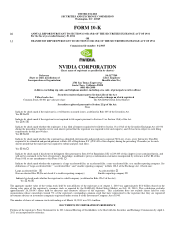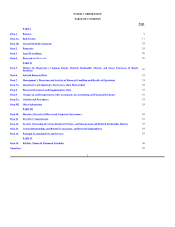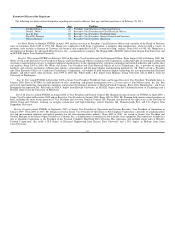NVIDIA 2011 Annual Report Download - page 7
Download and view the complete annual report
Please find page 7 of the 2011 NVIDIA annual report below. You can navigate through the pages in the report by either clicking on the pages listed below, or by using the keyword search tool below to find specific information within the annual report.
Consumer Products Business
Our CPB is comprised of our Tegra mobile products that support smartphones, smartbooks, tablets, personal media players, or PMPs, internet television,
automotive navigation, and other similar devices. CPB also includes license, royalty, other revenue and associated costs related to video game consoles and
other digital consumer electronics devices.
Our mobile strategy is to create a system-on-a-chip that enables entertainment and web experiences that end users enjoy on a PC. NVIDIA Tegra mobile
products implement design techniques, both inside the chips and at the system level, which result in high performance and long battery life. These
technologies enhance visual display capabilities, improve connectivity, and minimize chip and system-level power consumption.
During fiscal year 2011, we continued to see promising signs in our Tegra business, helped by the widespread consumer adoption of the Android
operating system. Tegra shipment volumes began to ramp up late in the fourth quarter of fiscal year 2011 and we expect the momentum to continue into the
first quarter of fiscal year 2012, fueled by the production release of Android-based smartphone and tablet products. During fiscal year 2011, we had multiple
Tegra 2 design wins in both tablets and smartphones. Our customers including Acer Inc., Dell Inc., LG Electronics Inc. and Motorola Solutions, Inc.
announced a number of products incorporating the Tegra 2 mobile processor. We also demonstrated our next-generation mobile processor, the world’s first
quad-core mobile processor, at Mobile World Congress.
During fiscal year 2011, we announced that Volkswagen AG and Audi AG will use our next-generation Tegra starting in 2012. In addition to this, we
announced that BMW will use our GPUs for infotainment systems in next-generation cars worldwide. Tesla™ Motors will also incorporate Tegra processors
to power the infotainment, navigation and instrument cluster in its Roadster Model S.
Our Strategy
We are committed to bringing the best experience to the end user through our innovative hardware and software offerings. We design our products to
enable customers in the visual computing, high-performance computing and mobile computing markets to build products that deliver state-of-the-art features
and capabilities, performance, compatibility and power efficiency while maintaining competitive pricing and profitability. Our business strategy leverages our
ability to design and develop programmable GPUs, system I/O processors, system-on-chip processors, application programming interfaces for multiple
operating systems, and application programming tools and middle-ware to provide our customers with platforms that allow superior performance and utility
beyond the base capability. We believe that by developing hardware and software platforms that provide superior performance and address the key
requirements of each of the product categories we serve, we will raise the capability of each system and further accelerate its adoption. We combine scalable
architectural technology with mass market economies-of-scale to deliver a complete family of products that span from professional workstations, to consumer
PCs to tablets and smartphones.
Our objective is to be the leading supplier of programmable, high-performance GPUs and ultra-low power mobile system-on-a-chip products. A
fundamental strategy is to actively recruit the industry’s best 3D graphics and HD video, microprocessor, networking and communications engineers, and we
believe that we have assembled an exceptionally experienced and talented engineering team. Our current focus is on the desktop PC, professional workstation,
notebook PC, high-performance computing, and application processor product lines, and we plan to expand into other product lines. Our strategy to achieve
this objective includes the following key elements:
Sustain Technology and Product Leadership in Visual Computing. We believe that ongoing investment in research and development in 3D graphics
and image processing is critical to the development and enhancement of innovative products and technologies. We are focused on using our advanced
engineering capabilities to accelerate the quality and performance of 3D graphics, image processing, and computational graphics to raise and change the user
experience for both consumer entertainment and professional visualization applications. Our research and development strategy is to focus on concurrently
developing multiple generations of GPUs, including GPUs for high-performance computing, and mobile and consumer products using independent design
teams. As we have in the past, we intend to use this strategy to achieve new levels of graphics, networking and communications features and performance and
ultra-low power designs, enabling our customers to achieve superior performance in their products.
5




















